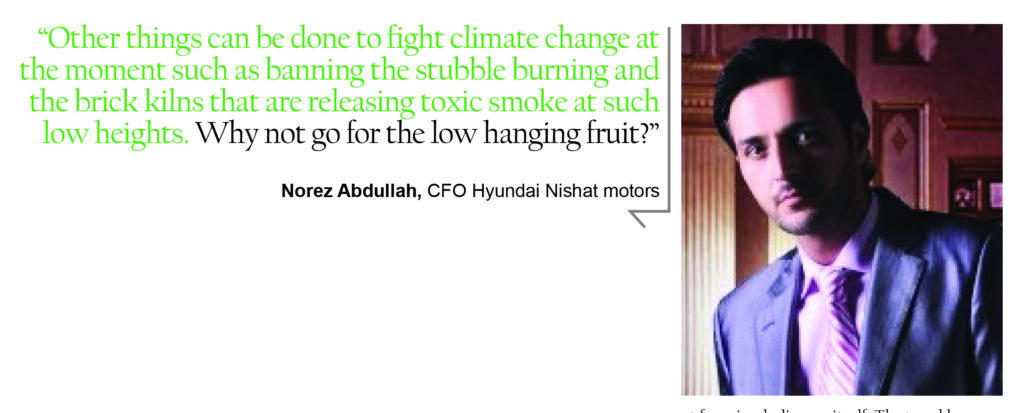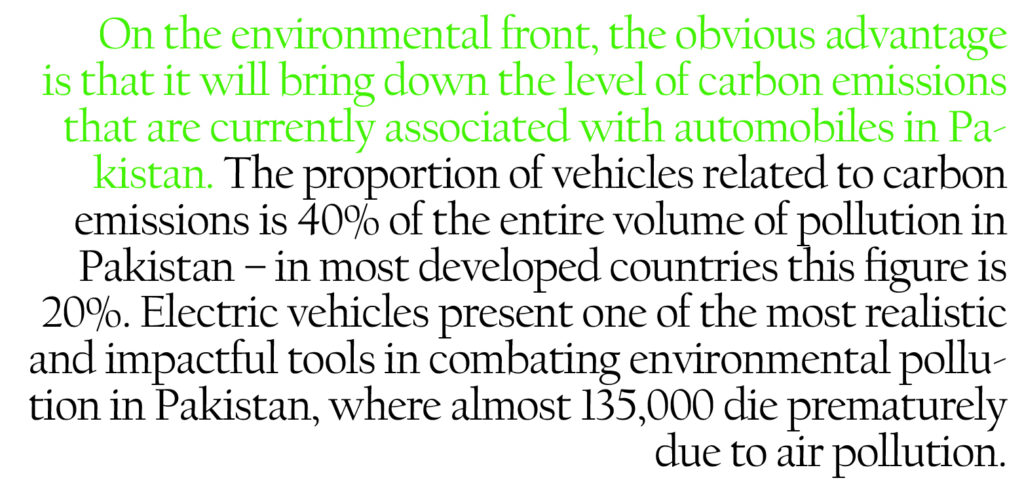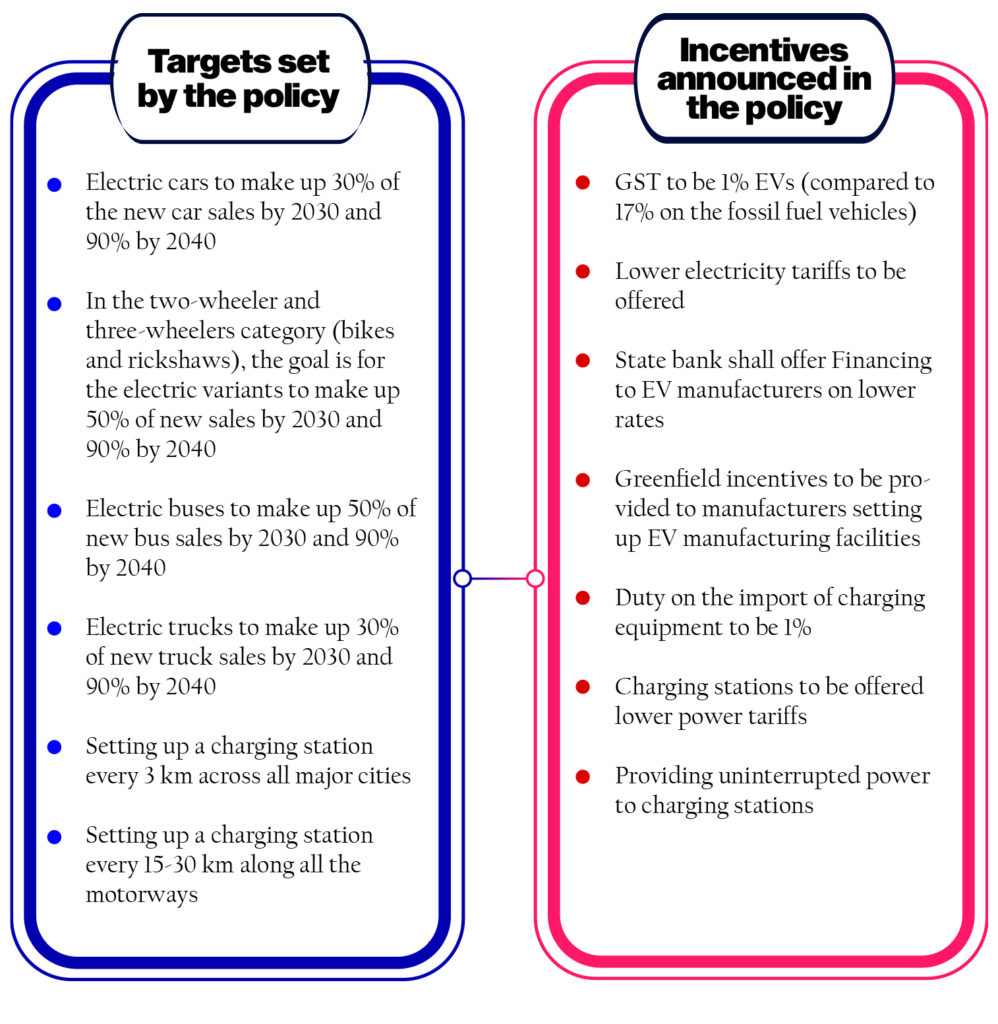The current debate in the United States is whether or not they are going to be able to cut down carbon emissions completely by 2030. The climate crisis dominating the world and causing global changes in politics, refugee movements and global relations has rung the alarm bells late. Within the ongoing democratic race for the American Presidency, Senator Bernie Sanders’ Green New Deal promises an end to 71% of emissions within the US, and a 36% cut to emissions in less industrialized nations in the world. His opponent, former Vice President Joe Biden, claims that no leading scientist in the world agrees with the Vermont Senator’s plan.
Pakistan has a 2030 goal too. In its first-ever electric vehicle policy, approved by the federal cabinet back in November 2019, the incumbent Pakistan Tehreek i Insaaf (PTI) government announced that it aims to convert 30% of the vehicles out there into electric vehicles by the year 2030.
It is a goal that no one could logically disagree with. Electronic vehicles would not just be good for the ailing environment, but also a possible way to revive the bruised and beaten auto industry. The goal is, no doubt, a commendable one to pursue. Commendable, but ambitious, and ambition can be a grievous fault.
For the first time, the government seems to be serious about climate change. But the electric vehicles and the electric vehicle policy is being seen as more than just a tool to combat climate change – at least by the government. Pakistan faces multiple problems today and the proponents of the electric vehicles believe that they present a solution to a number of those problems.
A transition to electric vehicles holds plenty of benefits, but the real question is how will Pakistan make this transition? Will it really even happen, or does it risk meeting a similar fate of the much hyped but ultimately inconsequential billion tree tsunami?
A good sign is that all the major auto-manufacturers have shown serious reservations against the initial Electric Vehicle policy. But while these reservations indicate the sweats, it may also mean opposition. Profit takes a look at the salient features of Pakistan’s first Electric vehicle policy, to give you an idea of what the government aims to achieve with it, and whether or not they are biting off more than they can chew.
The what’s what of the EV policy
The transition towards electric vehicles is part of the global movement trying to do all the large and small things to try and save the planet from imploding on itself. The trend has picked up particularly since 2017, as governments all over the world made substantial strides towards this transition and a number of them announced their electric vehicle policies. Pakistan, being the 7th most vulnerable country to the effects of climate change, was bound to follow sooner or later. Fortunately, as far as just making a policy goes, Pakistan has been quick on the uptake with the policy rolling out just last year. It drafted its very first Electric vehicle policy which was approved by the federal cabinet after thorough deliberations.

The Policy aims to promote electric vehicle adoption, setting up of necessary infrastructure, and incentivizing the buyers and the manufacturers. Its primary features have been listed out for you, but there is still more to it that has been hinted at by the government. Chief among these hopes is that almost 3000 CNG stations will be converted to EV charging stations.
Not just a climate thing
As far as perspectives go, Pakistan has been well received for their efforts on the EV front. The praise for drafting its first electric vehicle policy and joining the ranks of the “environmentally responsible” and progressive countries of the world is well deserved. And while the fuzzy warm feeling that comes with doing the right thing should be enough, the government is looking forward to some other things as well.
On the environmental front, the obvious advantage is that it will bring down the level of carbon emissions that are currently associated with automobiles in Pakistan. The proportion of vehicles related to carbon emissions is 40% of the entire volume of pollution in Pakistan – in most developed countries this figure is 20%. Electric vehicles present one of the most realistic and impactful tools in combating environmental pollution in Pakistan, where almost 135,000 die prematurely due to air pollution.
But besides serving as a useful tool to fight climate change, the transition to electric vehicles as envisioned in the EV policy will have several other benefits for Pakistan.
Consumers will get to save on fuel and maintenance costs for starters, something hybrid users can already tell you. An average motorbike user can expect his fuel consumption to drastically reduce from around Rs7000 per month to under Rs1000 a month. Similarly, an average 800cc car owner can expect his monthly fuel expenses reduced to almost RS1200. On the national level, we’re looking at potentially massive savings in foreign exchange due to a reduction in oil imports in the long run. Almost $2 billion is associated with the oil imports used as fuel for vehicles.
The minister for climate change, Malik Amin Aslam, has also spoken on several occasions about how a transition towards electric vehicles will help cut back oil import bills that are running into billions every year, how it will create new jobs by giving birth to an entirely new industry, and how Pakistan can go on to become an exporter of this new breed of vehicles if it takes the right steps now to establish itself in this area.
That sounds like an excellent plan – at least on paper – but there are going to be serious hurdles when it comes to the execution.
It’s not going to be easy
As with everything, however, making a nice shiny policy is doable, actually following up on it not so much. Many believe that the transition to electric vehicles as envisioned in the EV Policy will not be a walk in the park, and for good reason too, if precedent is anything to go by.
For starters, such a massive transition cannot be achieved unless you have the full support of all the major stakeholders. The primary stakeholder – the auto sector – is not supportive of the EV policy introduced by the federal government a few months ago.

Mr. Norez Abdullah, CFO Hyundai Nishat motors, told Profit that there were several issues with the first electric vehicle policy that came out in November. To begin with, appropriate stakeholder consultation did not take place when the policy was being framed. Besides, he believes that the Ministry of Climate Change, which practically spearheaded the policy, is not the relevant ministry to have done so.
The Ministry of Industries and Production (MOIP) and its apex body, the Engineering Development Board (EDB) are the relevant bodies that can understand the dynamics of the auto-sector. He further said, that they are not against the electric vehicles transition but believes it’s “ahead of time” and that hasty decisions and policies that lack proper stakeholder consultation and understanding of the industry, will only hurt the already frail auto-sector, not benefit it.
He further added that the policy lacks clarity. The government has made grand claims such as saving almost $2 billion yearly in fuel imports by switching to electric vehicles. He questioned the veracity of such claims and added that the costs that will go into making such a transition are huge. There is no infrastructure available yet to support such a transition and the government does not seem to have a concrete road map as to how they will go about setting it up.
The natural question that arises is that it is, at the end of the day, not just about the costs, but the environment as well.
“Other things can be done to fight climate change at the moment such as banning the stubble burning and the brick kilns that are releasing toxic smoke at such low heights. Why not go for the low hanging fruit?”
“We have nothing against electric vehicles, but the market here in Pakistan (with a per capita GDP of $1357) is not ready yet. Contrary to popular belief, electric vehicles are even more expensive than traditional vehicles. So among other things, it doesn’t even make much business sense at the moment.”
While this was still a clear skirting around the environment question, he said that electric vehicles are a novel technology and that Pakistan, given its economic restrictions, cannot afford to be the first mover in this uncharted territory.

Most other players from the auto-sector have had issues with the first electric vehicle policy but declined to comment on it as it is in the process of revision now. A committee has been formed with the MOIP and other relevant bodies on board this time and the Final electric vehicle policy will decide what will be their future course when it comes to manufacturing Electric vehicles.
One middle ground may be that only two and three wheelers are converted to electricity, and regular cars still be allowed for general use. The rate of motorization in Pakistan is quite low anyways. Only 9% of households own a car according to the Pakistan Bureau of Statistics (PBS).
The auto-sector has been on the verge of collapse due to declining sales over the last year. It was natural then, that any move which stands to further hurt the ailing car industry (such as the EV policy and the intended transition towards Electric vehicles) would be fiercely resisted –and so it has been as we saw.
However, the market for two-wheelers and three-wheelers is a different arena altogether. As per PBS data, more than half the households own a motorcycle in Pakistan. And it presents a ray of hope for the intended transition towards electric vehicles. The market is huge, and the electric bikes and rickshaws will not cost as much as the electric cars do. The two-wheelers and three-wheeler manufacturers stand to gain from such a transition.
Sooner than we think?
From what informed sources have revealed to Profit, the government may actually have a similar plan in mind to take this transition forward. Going for two-wheelers and three-wheelers first makes sense. They make up the larger chunk of vehicles out there. And if they can be converted into electric vehicles, the aims of the government to combat climate change; slash its oil import bills; create new jobs or even become an exporter of electric vehicles and related components can be met to a great degree. Besides, it can pave the way for a more comprehensive transition to electric vehicles in the longer run.
Profit spoke to Mr. Muhammad Ayaz, Senior Vice Chairman of the Pakistan Electric Vehicles Manufacturers Association (PEVMA) in this regard. He revealed that an S.R.O will soon be issued (probably by the end of February, he speculated). “This will pave the way for at least, the electric bikes and electric rickshaws to be put into production. I am optimistic about the future of electric vehicles in Pakistan, and believe that we may begin to witness this new breed of three-wheelers out on the roads sooner than we thought.”
A recent development that goes to validate his claims is the launch of Sazgar’s electric rickshaw. Sazgar is the largest and most trusted rickshaw manufacturer in the Pakistani market. Surprisingly, it has also been exporting three-wheelers to markets such as Sri Lanka and even Japan, revealed Sazgar’s Sales head, Ismail Ghaznavi.
Are the consumers on board?
Consumer is King, as the famous marketing adage goes, and they represent a major stakeholder in the transition towards electric vehicles. Profit spoke to a number of them to gauge how they feel about such a transition. The bike owners seemed more willing to switch to the electric variants than the rickshaw owners.
One of the major reasons for this is that the rickshaw owners, generally, are not as informed as the bike owners about the technology and the benefits it can provide. But when told about the potential cost savings that the new technology will offer, most of them seemed enthusiastic to find out more. They were, however, convinced that it will take a long time before these new rickshaws will finally hit the market.

One of the major concerns of both, the rickshaw and bike owners out there is the availability of charging infrastructure. When told about Sazgar’s electric rickshaw that charges off of a household socket and can go up to 170 km on a 5-hour charge, most bike owners seemed convinced that such an arrangement in a bike would more than work for them even in the absence of widespread charging infrastructure. The rickshaw drivers, however, were still skeptical about such a transition due to the range anxiety issues.
The good news and the bad news
It is safe to assume that the current government is genuinely serious about making a large scale transition to electric vehicles. That, in itself, is good news, to begin with. The further good news is that even if the transition to electric cars is not a viable option right away, we can begin with the two and three-wheelers.
The market is huge and growing when it comes to two and three wheelers – Pakistan is the 5th largest market for bikes in the world and it is already exporting three-wheelers to markets such as Japan and Sri Lanka. And contrary to popular perceptions, there will also be excess electricity capacity to power such a transition in the coming years as pointed out in “Electric Vehicles in Pakistan” report by LUMS.
A lot depends, however, on the electric vehicle policy that is unsettled and in revision at the moment. The ability of the government to come up with a consistent policy to incentivize all the major stakeholders and facilitate such a large scale transition is paramount. But as we have seen on several occasions, the current government, despite best intentions, fails miserably when it comes to execution and delivery – and that is the bad news.





Grateful to Mr. Furqan Malik of Profit contributors Mr. Norez Abdullah CFO Hyundai Nishat Motors, Honorable Minister Malik Amin Aslam Ministry of Climate Change, Dr. Saleem Janjua Country Coordinator (GEB) the MOIP, EDB, Mr. M. Ayaz Sr. VC PEVMA as a student of Honorable Dr. Saleem Janjua Pakistan blessed with personalities as Dr. Janjua.
It is well known to us for Lahore city one of the worst affected by Climate Change one of the possible reason which possibly Dr. Janjua may endorse is very close to Lahore the Indian side has coal fired power plants which is possibly affecting Lahore.
It is most essential for us to determine the exact source affecting Lahore is due to emissions at cross border India which is polluting our cities. We need humble advise on this issue is how this could be addressed.
One of the things which I may be able to explore the emissions from the international satellites and the related carbon emissions from satellite co-ordinates of Longitude, Latitude of international weather satellites.
We need policy guidelines from the respective authorities under Climate Change worldwide. The most important is the bus assembly of Volvo, Hino Pak and others should essentially be on EV guidelines. The standard EV batteries should essentially be imported of international standards. Charging Stations should be all at the petrol filling stations of all companies in Pakistan as common practise with known companies in Pakistan as Shell, Total, to make investment in the charging infrastructure with their incentive to business at the same place of their petrol pumps.
Comments are closed.